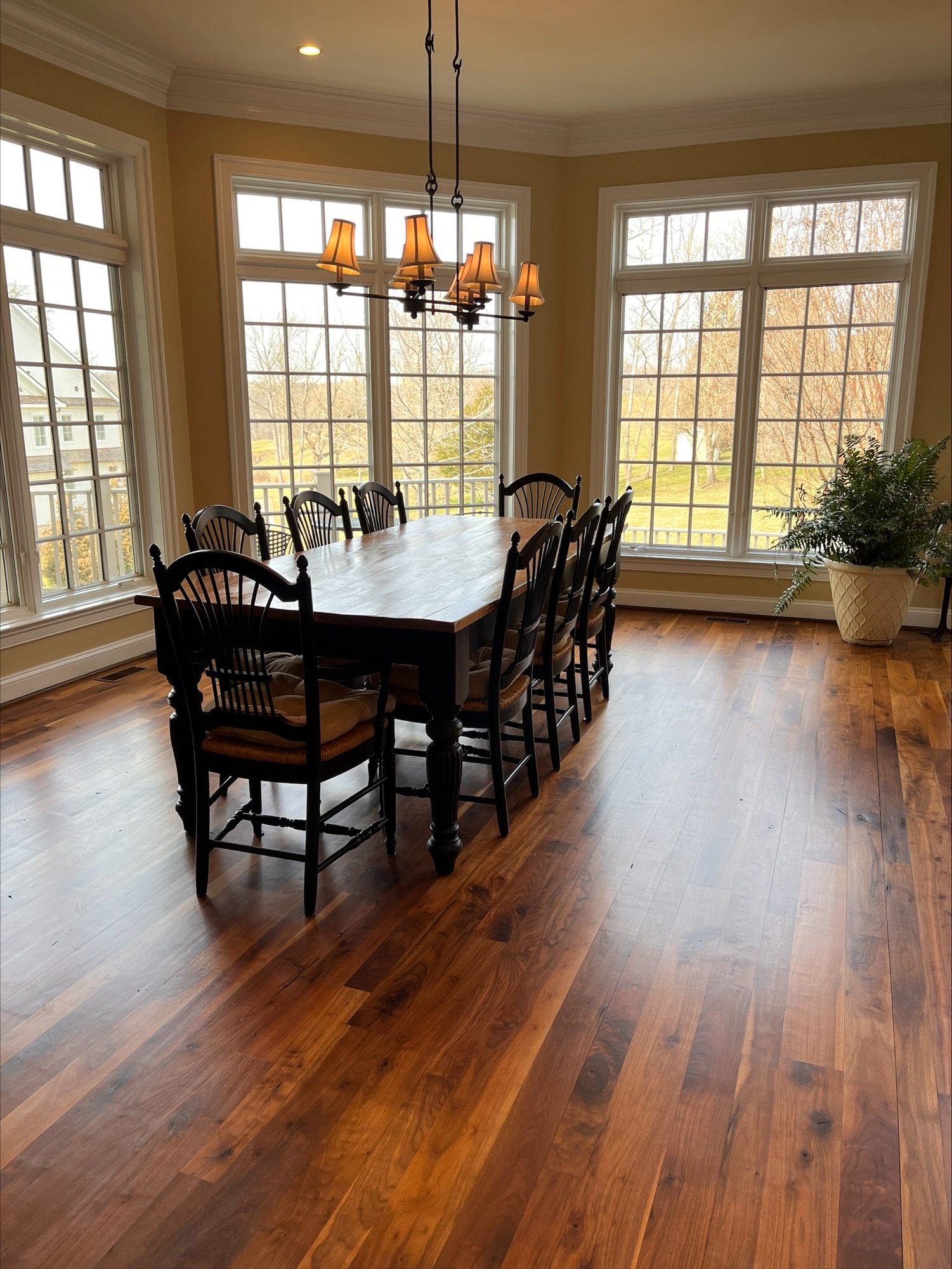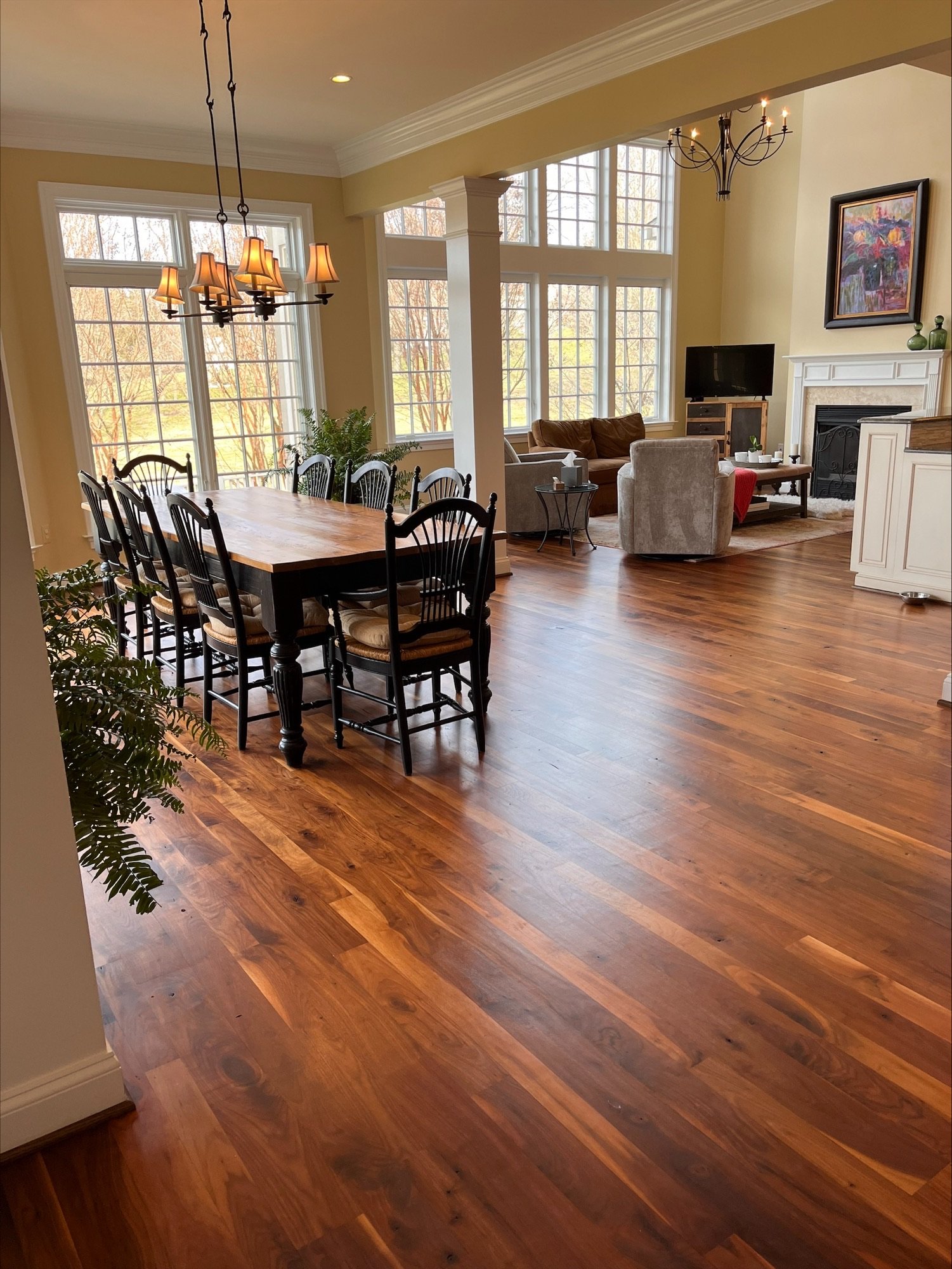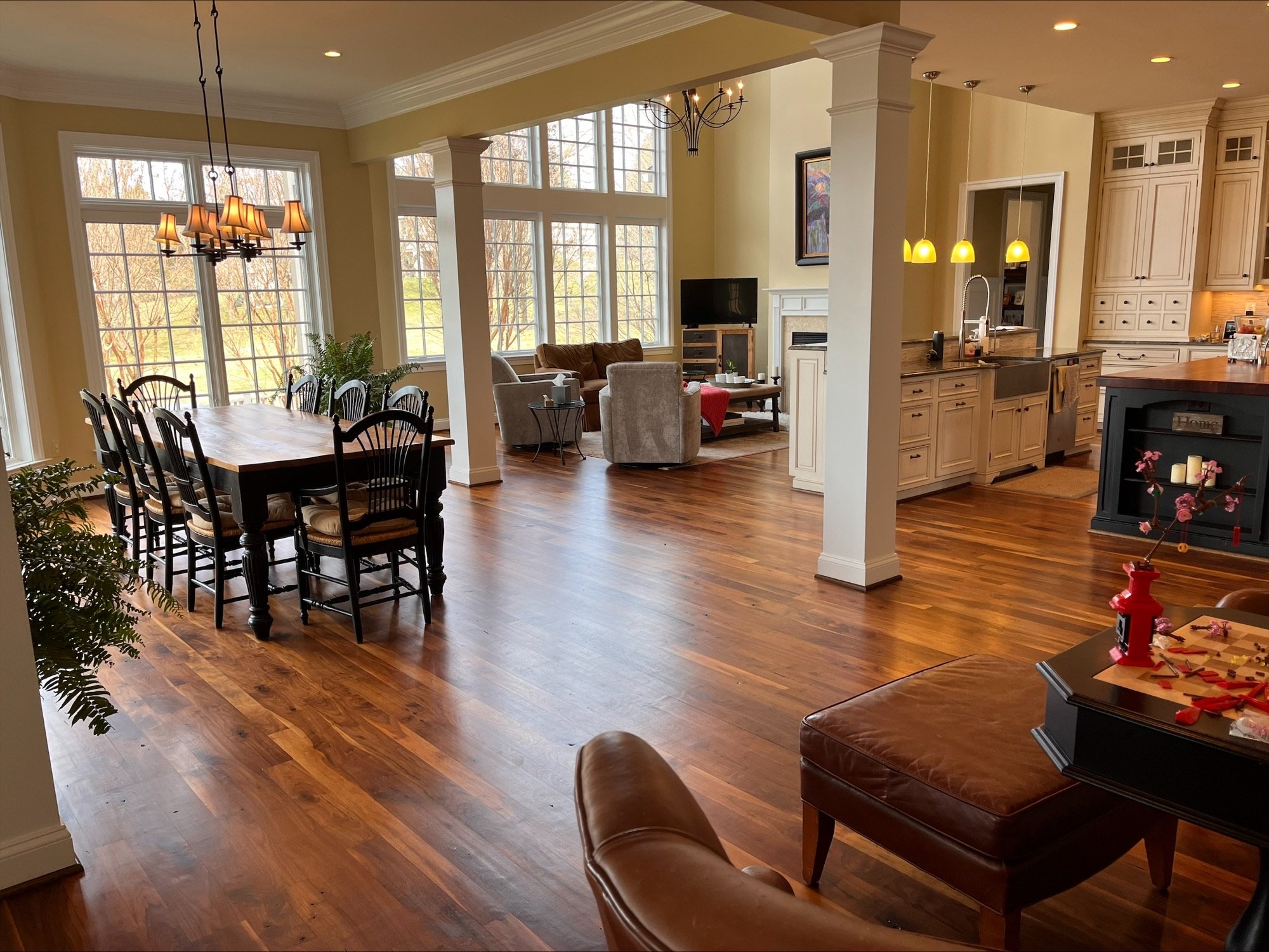Listener Q&A- How To Choose A Rug
In this episode, and a Slow Style Home Podcast first, I had a conversation with one of our listeners, Lisa, about a common design dilemma - choosing the right rug. Specifically, how to choose a rug to go underneath the dining table.
LISTENER Q&A: How To Choose A Rug
Lisa's home on the first floor is very open. There are some architectural details that define a couple of areas distinctly. We're looking at the family room, kitchen, and dining room.
Her question is about the dining area in particular. I say dining area and not dining room because she does have a separate dining room, a more formal dining room, in another part of the house.
This one is really open to the family room and the kitchen and so therefore it feels to her more like a kitchen table. But it holds eight people or more. I mean, actually, the dining area that we're talking about is really very large. In fact, it's so large that the other end of it is big enough that she's created a little seating area with two chairs and a little table. It looks into the family room and it looks into the kitchen.
Let's jump in with Lisa.
Lisa: My question to you is, how do you find, and what do you put under the he kitchen table? The first thing I think about is food and it getting crunched into the carpet. So what kind of material do you need to get so that it can be cleaned? I've seen different material types that I have no idea what they're talking about, but I don't want that fabric that's really hard, like that beachy kind that's kind of like straw, where it's kind of hard on the feet and it's not comfortable.
Zandra: Sisal. It’s hard on the feet.
Lisa: Yeah. Don't want sisal.
WHAT AREA RUGS DO FOR OPEN FLOOR PLANS
Lisa: I don’t know the rules about rugs. I understand why my friends tell me I need a carpet under that table. And I know the term “grounding it”, but could elaborate on that? What does that mean exactly? And how do you tie the color in?
Zandra: I can see why your friends have said, Oh, you need a carpet to ground this spot. And I think what they mean is to delineate. When you have open floor plans, that's what many people do. They use rugs to delineate the different activities that are happening in the same room. So just as a rug is delineating a conversational area in your family room area, you've got a TV, you've got a couch, everything is around that carpet.
I would push back on that just a little bit and say that the shape of your dining area, in some ways, is already doing that for you. You've got these wraparound windows here and the chandelier. So if you really don't want to have a rug for reasons we're going to get into in a minute, then think about the fact that this area, because of these windows, because of the chandelier is already pretty much it, we can ground it so called grounded in other ways.
What you might consider instead is doing a little area rug where the seating area is instead. That would delineate this seating area from the dining area, because those two things are in the same room. If you just had one carpet under the seating area, which again is two chairs, a little table, that may do the trick, that may break up this space into two distinct areas.
Now, let's talk about what you would do, though, if you did want to get a rug in the dining room area and what considerations to make.
WHAT DOES “GROUNDING THE SPACE” MEAN?
Let's talk about the grounding thing first. Grounding has to do with visual weight and visual weight is when you look at something depending on its scale, its overall size and the quality of the material and how transparent it is, the more of all of that you have, the more visual weight you have.
So if you think about, let's say a desk, right? And it's made of wood and it's got wide legs and it's chunky, it's going to have a lot of visual weight and it's going to ground the space that it's in because it's in the lower third of a room.
When you scan a room horizontally, and you think about breaking it up into thirds, the lower third is where most of the furniture is, desk is going to really ground that space.
However, if you have a lucite table, which is like an acrylic clear see through table in that same spot, that is going to open up that lower third of the room, and it's not going to feel as heavy.
And there are times for both. There's no right or wrong. There are times when you want to lighten up a space and times when you want to ground a space. My take on your living room area is that the table and six chairs or eight chairs is already a lot of stuff. It does not lack grounding in my opinion, but I do believe, and I say this all the time, you know, I'm talking about rules, but I also really believe that it's in the eye of the beholder and it's got to feel good to you.
If it feels off to you because you don't have a rug, then by all means, let's make sure you get a rug. But, but in my opinion, it does not feel ungrounded. If anything, I would maybe, like I said, um, Put a little area rug in the little seating area to make that space feel even more intentional. Okay, let's go back to the rug question itself and what kind of rug to get.
WHAT MATERIALS TO CONSIDER FOR YOUR RUG
So I think you're absolutely right. Food is an issue, but it's not as much of an issue as you may think, unless you have small kids in high chairs. Which I don't think you do. It doesn't look like you do based on the house that you have. I do not see any child paraphernalia in any of your rooms. So that doesn't mean that adults don't spill things. It just, in my mind, means it doesn't happen as often. And it's really not that big of a deal if, if you do.
I think a sisal rug or anything that has a high pile, you know, a really plush rug is going to trap food and be a little bit more of a pain in the neck to get out than a flat weave rug. So I would avoid anything that's high pile or sisal, anything that's, you know, got that nubbiness to it.
So we're talking about flatweave and there's all kinds of flatweaves. I mean, Oriental rugs, Turkish rugs, they are flatweaves, so it doesn't even have to be a new rug. It can be an old, beautiful oriental rug that already has some wear and tear. Then you don't mind there being a little bit of food that you have to then vacuum up or a little bit of wine that spilled or whatever.
I think a pattern hides things so much better than a, than a single solitary color or even a couple of neutrals together. You talked about having a neutral rug, which is fine, but I would, I would lean toward a pattern to hide all of those potential issues. mishaps. The other thing a pattern is going to do is it's going to make the rug potentially feel like more like it's an intentional design element as opposed to something that you put down because you thought the space needed it.
That's not to say you can't find a neutral rug lacking pattern that's not going to look fabulous and beautiful. I'm just saying what it, what is sort of the easier thing to do? Because you're going to be, I'm sure you already are, overwhelmed with choices.
WHAT SIZE RUG SHOULD YOU GET?
Talking about size of the rug, There are lots of people out there who do not use any rugs under their dining room table, and they don't like it It's not just the food It's the issue of the chairs coming in and out in and out if those chairs can't slide easily on that rug It's gonna drive you up a wall. So I agree with you that the rug needs to be at least wide enough that all of the chairs can be pulled out. Somebody can physically get up out of them and the chair never comes off the rug. None of the legs come off the rug.
So we are talking about a large rug, which means it's expensive. Even if you get like a cheapie rug at Home Depot or something, the, the larger the rug, the more expensive it's going to be. My preference is to go with something that's much more well made, especially in a high traffic area like a dining room, because those cheaper rugs really don't last. What happens especially is the corners start to curl up and people trip on them.
So I'm talking about investing in either a new, patterned, well made rug. It can be modern. It can be traditional. OR going thrifting, antiquing, and looking for some older rugs, which will be Turkish, Ottoman, what we call Oriental, which is a great way to, to do it to save a lot of money. They're actually not as hard to find as maybe you might think. You can go online and look for used vintage rugs.
HOW WILL THE RUG WORK WITH THE REST OF YOUR STYLE
We can get to sourcing in a second, but, but we're talking right now about size and material. So we want to cover sourcing and we want to cover how it kind of ties in with, with everything else. What do you want to talk about first?
Lisa: How it ties in with everything else.
Zandra: Okay, so I'm going to let you describe your style. What are you seeing in this room?
Lisa: So visually, what I've always enjoyed about our house is that we have a central family areas. We like the energy together. When we moved in two years ago, thankfully, the people left behind their table and chairs. I had the chairs painted black because it was a little too country for me.
You'll see all of the light fixtures are a wrought iron. Overall it feels almost Western. There's a lot of stone, there's the fireplaces. Two leather, high back chairs and an Ottoman. And the family left behind a chess table. So we play chess there.
And then the picture behind it, my friend that I worked with at Microsoft started doing art. And she created that piece and we bought it from her to support her artwork. And we love it so much.
The colors in the artwork I thought really tied everything together. So I like the deeper warmer tones. A blue-red, a raspberry red, that type of thing.
I’m big on conversations. So I don’t want to exclude anyone. We always have these gathering places and make sure they’re conducive to the dogs, the toddlers, the people who sit and not move all day, but are super comfortable and they're part of the group!
Zandra: It's lovely. The walls in the photo I'm looking at, they look kind of like a yellow buff kind of color.
Lisa: Yep. There, there's a lot of gold here. The yellow color has worked because it's a lot of wall and I really don't want to pay to paint it a different color. Also it matches the fireplace and everything. And the floors are so beautiful and deep.
And that's another thing, like I don't want to necessarily have something so light and neutral that it just like screaming and it doesn't fit. But at the same time, I don't want to go dark because we already have dark on the floor. You know what I mean?
GETTING AWAY FROM GENERIC DESIGN CHOICES
Zandra: I think what we want to make sure doesn't happen is, we're trying to get away from generic decorating and really hone in on your signature style. And so for the rug, I would find something that has the colors and a pattern that just make you giddy, that you just absolutely love. And I would think too, about where you fall on the old new continuum in terms of mixing things together.
So “I love antiques and I love old things” is on one end, and then on the other end is “I like everything new, I like everything to be in perfect condition and streamlined,” and however you define old and new or whatever those two words kind of conjure up in your head. Ask yourself, where on that continuum do you fall?
I believe that most rooms feel like they are alive when there is a mix. I don't dictate where on the continuum you should fall. I'm just saying when you go all the way to one end and everything is brand new, or you go all the way to the other end, everything is old, the room is going to feel like it's notlived in. And that's because when we mix old and new together, we are saying that our homes are evolving. They're reflecting an evolution of our own lived experience because we do collect things over time and they are then an expression of who we are over time and different aspects of our personality, different aspects of what we were interested in at different points in our lives.
So in this room, I would say to you, look around and see what elements do you feel are missing? Is something older of missing? Something worn? Is pattern missing? Is a shot of color missing? And then you go, okay, well, like you said, I love these reds and and like raspberry red and I like this gold color I see in that abstract painting. There's a little bit of blue in there and you may want to find a rug that just really celebrates the love that you have of those colors because it sounds to me like they really mean you really feel strongly about them.
Then you can decide how modern do you want to go? How old do you want to go? And, and, you know, continue your search that way.
And then of course you have to go on size, which will always be the hang up. I would get some painter's tape out and I would lay out the perimeter of what you're looking for on the floor and I would go as far as you can go with the chairs pulled out and then measure and see how big are we talking and then go as far as you can go with somebody still being able to get out comfortably and see how small you can go.
HOW TO FIND A GREAT RUG THAT FITS YOUR NEEDS AND STYLE
So we’ve talked about pulling in some of the colors that you love, making sure it's big enough, making sure it's a flat weave. On to sourcing. Going to finding antique rugs, if you want to go that route, you can find great deals on rugs at large antiques shows, ones that are set up with booths and tents, usually 1-3 times a year. And there are vintage rug shops online.
In fact, there's one called The Vintage Rug Shop that you could try. There is another one called Revival Rugs, and they have a mix of old rugs, which are one of a kind, and new rugs that they make. They're all very well made. They're natural dyes. The weaving is very well done, so it's going to last for a long time.
Or, if you want a new rug, or one with a more modern aestheteic, we're talking about going to a place like an actual honest to goodness rug store. Then we're talking…I mean, a rug that big, it could be $9,000. It could be $12,000. I mean, it gets expensive when you buy new quality rugs. Otherwise, you're going to Home Goods or Home Depot or whatever and it's just not going to last.
USING WHAT YOU ALREADY HAVE, FIRST
Lisa: Actually, the family left a bunch of oriental type carpets behind. Which we've used everywhere, but I'm thinking the one in the family room has a bit of a gold touch to it. So I'm wondering should I put that there, and I can try it out, right?
Zandra: I love that idea and I recommend it all the time to use what you already have! And and I I think what's gonna be really helpful in this case is that since it's a lighter color, that's going to be so helpful for you to decide, do I want to go darker? Or do I want to stay lighter? Because I think that's going to really help you narrow things down.
Then when you're out and about, you're at an antique show or fair, or you're, you're, you're looking online or whatever, you know, you can keep scrolling or keep walking, past the light colored things or the dark colored things.
Lisa: I’m So nervous about area rugs…what if I make a mistake? I have friends that return things no matter what and they would return a rug, but I'm in the mindset of when you're dragging home a rug that weighs as much as a dead body, and you roll it out, and it's expensive as crap, do you want to roll it back up and put it back in the car and take it back? I think that's why I've done nothing. It's intimidating to figure it out.
But after my conversation with you now, I'm thinking, well, why don't I just try the other carpet and at least, you know, eliminate light versus dark or that type of thing?
Zandra: Absolutely. That is the most helpful thing I ever do in my own house is use what I already have and I can immediately see, oh my gosh, I thought, say, a dark rug was exactly what this room needed. And now it's like sucking all of the energy out of the room, like a black hole! You know, I just think you can get surprised sometimes. The fact that you have a rug that you can use as a placeholder is awesome. Y
Lisa: Makes sense. Thank you for all of the guidance and ideas and I love all of it. It's making me think.





